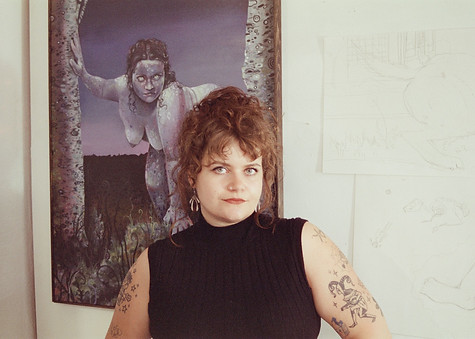
BIO
Olivia Faith Harwood (b. 1999, San Diego, CA, she/her) is a painter who currently resides in Portland, OR. She received her BFA in Painting at the Pacific Northwest College of Art in 2021. Harwood has recently received a Regional Arts and Culture Council Spring 2024 Arts3C Grant and a Regional Arts and Culture Council 2025 Professional Development Grant. She recently has been published in the 2022 Portland Critics Pick in Artforum, Spring 2022 Art & About Portland Blog and the Buckman Journal Issue 011, Uncanny. Harwood exhibited a solo show at Fuller Rosen Gallery in 2022, with two upcoming solo shows at One Grand Gallery in Portland, OR in October 2024 and a second solo show with Fuller Rosen Gallery in April, 2025.
STATEMENT
Inspired by board games, girlhood wonder, and folklore, Olivia Faith Harwood’s compositions captivate viewers with piercing eye contact and intensity. Household objects, trinkets, and scavenged sea glass swirl around her surreal paintings and sculptures, catching the eye like the glint of an earring on asphalt. She observes Oregon ferns with the same reverence as the shells collected from Florida’s beaches, where her family resides. Her dreamscapes draw from the places she calls home—Wisconsin, Oregon, and Florida—melding these environments into rich, phantasmagorical scenes. Through a vivid color palette, her work transports audiences to these familiar terrains, evoking both nostalgia and unease. These landscapes serve as portals into her interior worlds, revealing layers of trauma, rage, and deep emotion.
Blending nostalgia with societal critique, Harwood's work draws from girlhood memories—playrooms, childhood toys, whispered secrets—and juxtaposes them with the realities of womanhood. The result is a visually arresting and emotionally charged experience where creatures, monsters, and hybrid forms serve as guardians, protectors, and manifestations of resilience. Harwood’s work is about reclaiming power, confronting inherited behaviors, and embracing the untamed. It’s about protecting the girl Harwood once was and the women around her who continue to fight for agency and respect. The use of self portraiture, not necessarily using facial features but recognizable imagery, aids an audience in connecting with the canvas’ complex content.
Harwood’s work harnesses her anger and frustration, but also her fondness and love. It intertwines girlhood memories with current headlines and allows her to cope however she needs to. The artwork does not keep its hands to itself.


